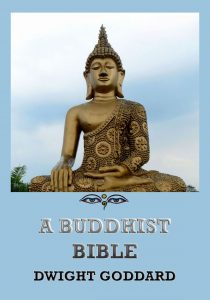A Buddhist Bible – Dwight Goddard
Indian Types of ethical and philosophical Buddhism did not easily find acceptance in China; it took centuries of contact before a distinctively Chinese adaptation of Buddhism was effected that proved to be congenial to Chinese soil. This Chinese type of Buddhism is called Ch’an in China, and Zen in Japan, and Zen seems to be the more familiar name for it in America and Europe. Other sects have risen and decreased but they proved to be more or less exotic, they never became indigenous as did Zen. An exception may be suspected in the case of the Pure Land Sects, but it should be remembered that the Pure Land Sects developed from Zen and not independently. To tell the story of this adaptation of the Indian type of Buddhism until it became fixed in the teachings of the Sixth Patriarch, is the purpose of this book. The main part of the book is given over to English Versions of the favorite scriptures of the Zen Sect. To this is added Historical and Literary Introductions and a few notes that seem to be called for to make certain phases of the Sutras more easily intelligible.

A Buddhist Bible
Format: Paperback.
A Buddhist Bible.
ISBN: 9783849675547.
Available at amazon.com and other venues.
What is Zen? (from wikipedia.com)
Zen (Chinese: 禪; pinyin: Chán; Korean: 선) is a school of Mahayana Buddhism that originated in China during the Tang dynasty as Chan Buddhism. Zen school was strongly influenced by Taoism and developed as a distinct school of Chinese Buddhism. From China, Chan Buddhism spread south to Vietnam, northeast to Korea and east to Japan, where it became known as Japanese Zen and known as Seon buddihism in Korea.
The term Zen is derived from the Japanese pronunciation of the Middle Chinese word 禪 (Chan) which traces its roots to the Indian practice of Dhyana (“meditation”). Zen emphasizes rigorous self-control, meditation-practice, insight into Buddha-nature, and the personal expression of this insight in daily life, especially for the benefit of others. As such, it de-emphasizes mere knowledge of sutras and doctrine and favors direct understanding through zazen and interaction with an accomplished teacher.
The teachings of Zen include various sources of Mahayana thought, especially Yogachara, the Tathāgatagarbha sūtras and the Huayan school, with their emphasis on Buddha-nature, totality, and the Bodhisattva-ideal. The Prajñāpāramitā literature[10] and, to a lesser extent, Madhyamaka have also been influential in the shaping of the “paradoxical language” of the Zen-tradition.
(The text of the last section was taken from a Wikipedia entry and is available under the the Creative Commons Attribution-ShareAlike License.)
Publisher’s Note: This book is printed and distributed by Createspace a DBA of On-Demand Publishing LLC and is typically not available anywhere else than in stores owned and operated by Amazon or Createspace.
